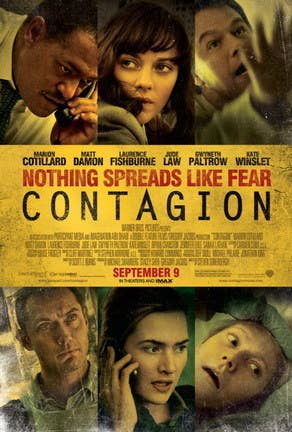#10: Nipah fever.

#9: The Black Death.
#8: Hendra virus.
#7: Rabies.
#6: Devil facial tumor disease.
#5: Yellow Fever.
#4: Polio.

#3: The flu.
#2: Smallpox.

#1: Something genuienly new.

Who loves a good epidemic? Not…not anyone. Like the VH1 Top 20 Video Countdown, only kind of more disgusting. Mira Grant, author of Parasite, Symbiont, and the bestselling Newsflesh trilogy, presents the Top 10 Future Epidemic Countdown! Remember, good hygiene and vaccination can protect you from many potential illnesses, as can adherence to basic quarantine procedures. Don’t panic, plan. And don’t use an outbreak as an excuse to be an asshole.

Show of hands: who saw the movie Contagion and thought that it was a lot of fun, except for the ridiculous way the virus got into the human population? (A fruit bat, driven from its original habitat by deforestation, dropped a half-chewed piece of fruit into a pig enclosure, infecting the pigs, who went on to infect the humans.) Ha ha, so many of us said, ha ha, that could never happen.
Let me introduce you to Nipah fever, one of the many exciting reasons that you may never sleep again. Nipah follows that exact chain of infection, and has a death toll of nearly 50% among impacted populations. Only the fact that it’s more difficult to catch and spread than the virus in Contagion kept it from being the next big thing—and since it’s part of a family of viruses we still know very little about, it has a lot of potential for the future. Movie’s not so ridiculous anymore, is it?
Everyone gets to have something silly that they feel very passionately about. For me, that “silly thing” is the Black Death, the virus which ravaged Europe from 1347 onward. Most people believe that the Black Death was a particularly virulent strain of bubonic plague, and have clear scientific evidence to support their claim. I belong to the school of thought which believes the Black Death was a previously (and currently) unknown hemorrhagic fever. We, too, have clear scientific evidence to support our claim.
Why is this important? It’s important because there are plague pits all over Europe, and as the modern human population expands, those plague pits are being opened and exhumed to make way for new development, train stations, and other necessary trappings of modern civilization. And that creates the conflict. If the bubonic plague people are right, the worst we have to worry about is a strain of plague that’s really good at killing, but which we have means of treating. If the hemorrhagic fever people are right, we could be looking at the return of a highly infectious, highly transmissible killer that took a break, but is happy to get right back down to the business of wiping out entire cities.
Hendra is a close relative of Nipah, which proudly holds the #10 slot on this list. They belong to the same family of viruses, the Henipaviruses. There are only three viruses currently known which belong to this family.
Hendra is interesting because it uses horses as a form of “super infector,” getting into their lungs and then allowing them to pump out frankly ludicrous amounts of live virus, all of which is ready and eager to infect new hosts. Humans are not as good for Hendra as horses are, producing only a normal amount of viral material, but still, it can have a good time inflaming our brains and chewing through our lungs, before leading to either recovery or death.
So far, all known outbreaks have been in Australia. I’m sure this will eventually change.
Everybody knows about rabies. It was the basis for Cujo, Stephen King’s heartbreaking novel of a boy, his dog, and the dog’s horrifying viral infection. It’s the reason your parents tell you not to play with baby raccoons. It’s the tragedy at the heart of Old Yeller. And it’s still out there.
Rabies is endemic in the mammalian population of North America, making it a risk for all outdoor pets that haven’t been vaccinated, and for humans, who are at least slightly less likely to go catching bats for fun. It’s treatable if you’ve been bitten, but it’s not curable if you’ve progressed to the point of becoming symptomatic. It’s not a pretty death, either.
Rabies is limited, however, in that it has never become airborne. There have been some indications of possible fomite or particle transmission in some bat colonies. If rabies manages to find a way to become person-to-person transmissible, it’s game over.
The Tasmanian devil population is currently being ravaged by a parasitic transmissible cancer which causes massive facial tumors, impedes airways, can dissolve parts of the skull, and can invade the heart. It’s unlikely that humans could catch this specific form of cancer, since it seems to be very fond of its current targets, but if one disease can do it, so can another.
Pleasant dreams.
Transmitted by mosquito bites and characterized by yellowing of the retinas, yellow fever is considered so dangerous that a single case on American soil is classed as an outbreak. It’s generally spread by mosquitoes that enjoy a warm climate, which is why it never spread to Canada during the North American outbreaks, at least one of which was caused by a tropical storm taking some infected bugs for a ride. The world’s a lot warmer now, and the tropical storms are a lot more common.
I recommend you invest in insect repellant.

It begins with a drop of water that has been contaminated with the feces of an infected person. It spreads from there throughout the body, infecting the nervous system and spine. It can be fatal. It can lead to permanent disability or disfigurement. It was the fear of all parents at one time, and is still the fear of parents all around the world. In 2014, the World Heath Organization called the outbreaks now happening in Asia, the Middle East, and Africa “extraordinary.” There is no cure.
It’s polio.
We have a reliable vaccine for polio: we have a way to keep it from spreading. But it hasn’t been considered a disease of great concern in America since the 1960s, and the polio vaccine is one of many to have been disputed by the anti-vaccination crowd. The return of polio to the nations where it is not currently a concern is not an “if,” it’s a “when.” I have nothing funny or pithy to say here. It’s coming. We could stop it.
We won’t.
People worry about novel diseases, things they haven’t encountered before or experienced themselves. We are, as a species, fully capable of getting extremely panicked over the idea that something new could rise up from the dark and kill us all. The trouble is, “stranger danger” is never as simple as it seems.
Every year, thousands of people die of the flu in America alone. It mostly kills older people, the very young, and the immunocompromised, but there have always been exceptions. The Spanish Flu was considered so very deadly because it targeted the healthy and strong. Those genes are still in circulation, still waiting for their chance to come back and hit us again.
People talk about the H1N1 scare of a few years ago as “overreaction,” and call the vaccination campaigns needless. But was the flu as much of a non-starter as it was because of that vaccination campaign? (And even for a non-starter, it did a lot of damage. It is not an outbreak to be dismissed lightly.) Since there’s a good chance the next flu scare won’t have as effective a campaign, I guess we’re going to find out.

“But wait,” you say. “Didn’t we successfully eliminate smallpox in 1978, after a global vaccination campaign, saving the lives of millions of children in the thirty-plus years that have passed since the last documented case of smallpox in the wild?” Gosh, you have a good grasp of epidemiological history! And yes, yes we did. But here’s the problem.
Smallpox still exists. We didn’t wipe it from the world: we just took it out of the wild and into the lab, where people have continued to study and tinker with it. Add this to the rise of the anti-vaccination movement, and when there is eventually a spill into our now non-resistant population, we’re going to be looking at a global outbreak. Smallpox is one of the most efficient killers the human race has ever known, and it’s poised for its comeback. All it needs is for someone to drop a vial, and the fun will begin.
So much fun.
We are discovering new diseases every day as we push further and further into the unexplored places of our world. Who knows what’s going to thaw out as the permafrost melts, or what we’re going to bring up from the bottom of the sea? Nature is endlessly inventive, and the virus is her surprise package. What’s in there?
You’re not going to know until you open it.
